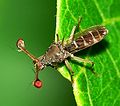Eyestalk (original) (raw)
From Wikipedia, the free encyclopedia
Protrusion that extends an eye away from the body
This article is about eyes mounted on stalks. For the instinctive tendency to visually track prey, see Eye-stalking.
Pulmonate land snails usually have two sets of tentacles on their head: the upper pair have an eye at the end; the lower pair are for olfaction.[1]
In anatomy, an eyestalk (sometimes spelled eye stalk and also known as an ommatophore) is a protrusion that extends an eye away from the body, giving the eye a better field of view.[1] It is a common feature in nature and frequently appears in fiction.[2]
Eyestalks are a specialized type of tentacle. Tentacles may also have olfactory organs at their ends.[3] Examples of creatures with olfactory tentacles include snails, the trilobite superfamily Asaphida, and the fly family Diopsidae. In slugs and snails, these tentacles will regrow if severely damaged, and in some species, are retractable.[1] Crustaceans also have eyestalks, consisting of two segments. [4]


Well-developed eye of Eustrombus gigas on eyestalk. There is also a small tentacle on the eyestalk.
Eyestalk of a lobster.- Eyestalk ablation
- The cephalofoils of Hammerhead sharks
- ^ a b c "Slug and Snail Anatomy". All About Slugs. Retrieved 7 December 2015.
- ^ Allayie SA, Ravichandran S, Bhat BA. Hormonal regulatory role of eyestalk factors on growth of heart in mud crab, Scylla serrata. Saudi J Biol Sci. 2011;18(3):283-286. doi:10.1016/j.sjbs.2011.02.003
- ^ "Snails and Slugs (Gastropoda) – The Tentacles of Snails". The Living World of Molluscs. Retrieved 8 December 2015.
- ^ Powar, C. B. (1969). "Musculature of the Eyestalk in Crustacea". Acta Zoologica: 127. Retrieved 17 August 2020.
